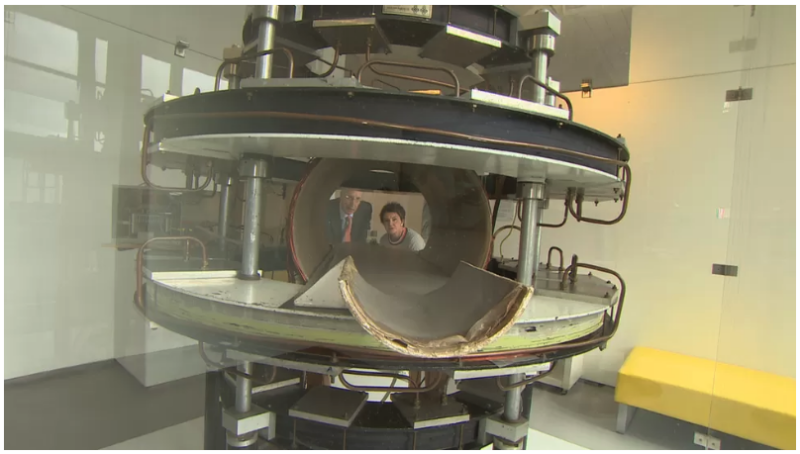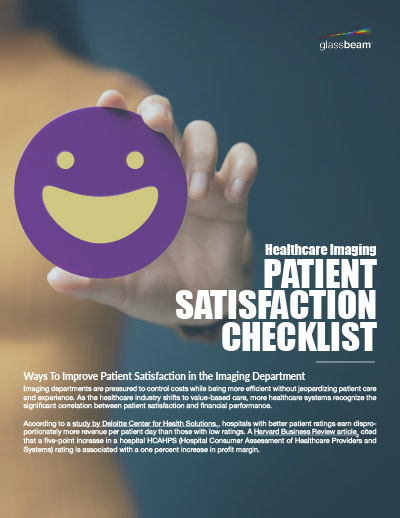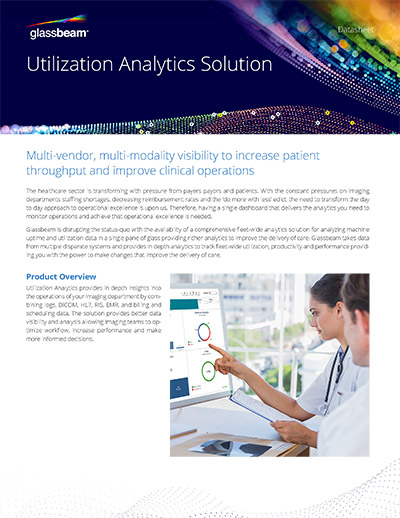
Top 5 Reasons Your Imaging Department May Be Underperforming
The healthcare industry depends on medical imaging to quickly provide accurate diagnoses and effective treatment planning. However, many hospitals and healthcare centers struggle to maximize their efficiency in radiology. Less-than-optimal imaging department performance can lead to costly delays, errors, and negative patient experiences that can limit business growth. Using healthcare business intelligence tools to identify problem areas, you can implement strategies to optimize your imaging department’s performance while consistently delivering high-quality care. We will explore five reasons why imaging departments may underperform and provide practical tips to supercharge your department’s operations.
1. Outdated Imaging Equipment and Technology
Medical imaging technology continually evolves, offering time-saving features and advanced analytics. According to Radiology Business, some advancements in 2023 include web-based enterprise imaging systems, off-site cloud storage for patient images, photon counting CT, and improvements in 3D mammography technology.
A growing number of imaging departments are implementing artificial intelligence (AI) to improve the ease and accuracy of diagnosis. The American College of Radiology estimates that AI adoption in radiology grew from virtually no use in 2015 to around 30% in 2020. Healthcare business intelligence technology is increasingly facilitating operational excellence that enables competitive advantages. Imaging departments that fail to stay current will have slower procedures, suboptimal image quality, and limited diagnostic capabilities compared to state-of-the-art departments.

The world’s first full-body Magnetic Resonance Imaging (MRI) prototype is on display in Aberdeen Royal Infirmary
To optimize your imaging equipment and technology, conduct a comprehensive assessment of your current equipment and prioritize upgrading outdated systems. Explore partnerships with vendors that offer innovative imaging solutions and consider the long-term benefits of investing in the latest technology. According to Statista, the worldwide market for diagnostic imaging devices is projected to grow at annual rate of 4.6% from 2023 to 2028, resulting in a market volume of $57 billion in 2028. To stay ahead and invest in the future of your imaging department performance, attend radiology conferences, keep up with industry news, and take part in tech productivity seminars.
2. Inadequate Staff Training and Employee Burnout
Staff training and employee wellness can have a significant impact on imaging department operations, including effects on patient safety, diagnostic accuracy, and employee burnout. Recently, The Society of Radiographers surveyed over 200 of their manager members. Almost 40% of respondents manage over 30 employees and 45% have not received any management training. Without the proper training, having responsibility for a large team can cause chronic stress, overwhelming workloads, and a lack of control. This can lead to burnout among radiologists, technicians, and support staff. Employee burnout not only impacts individual employee well-being but can also negatively affect imaging department performance.
Common symptoms of employee burnout include missing work, reduced productivity, emotional fatigue, and detachment. Unaddressed burnout can lead to low job satisfaction, high turnover rates, and lower-quality patient care.
To enhance your department’s training program, start by ensuring your department has structured training that provides for continuous learning and career growth. Access to workshops, seminars, and online courses can help employees stay current with the latest advancements and best practices.
A report by the American Society of Radiologic Technologists (ASRT) demonstrates that access to professional development positively influences job satisfaction among radiologic technologists. Technologists who receive training and educational support report higher levels of job satisfaction, which can translate to better patient care and improved imaging departmental performance.
To minimize employee burnout, encourage managers to delegate tasks to empower staff and improve morale. Regularly solicit employee input on ways to improve operations. Offer stress reduction resources for mindfulness, meditation, and mental health support. By proactively addressing the causes of employee burnout, you can contribute to the success of your imaging department.
3. Poor Patient Experience
Negative patient experiences can impact patient satisfaction scores, referral rates, and imaging departmental performance. Common measurable factors that can contribute to a negative patient experience include:
- Impersonal environment
Cold exam rooms, lack of privacy, and few patient amenities can make patients feel uncomfortable. - Inadequate explanation or access to exam results
Patients may feel anxious and confused if they receive limited explanations of what to expect or a complicated process to access their imaging results. - Long wait times
Being understaffed or disorganized can lead to extended patient wait times, inconveniencing patients and potentially causing anxiety. - Limited Scheduling
Complicated scheduling processes and limited appointment options can cause dissatisfaction among patients and their family caregivers.
Download the Patient Satisfaction Checklist
The American Journal of Roentgenology conducted a study that identified 1891 patient reviews for 1259 radiologists across the U.S. The patients ranked their experiences on a scale of 1–5 (1 being “terrible” and 5 being “excellent”). The most common score was 5 (62.7 – 74.3%), but the second most common was 1 (13.5 – 20.4%). The written comments showed similar polarization. The most prevalent words include “caring,” “knowledgeable,” and “professional,” but also “rude,” “pain,” and “unprofessional.” Patients often feel strongly – either positive or negative – toward their radiology experience. A study by Deloitte Center for Health Solutions found that hospitals with better patient ratings earn disproportionately more revenue than those with low ratings. To maximize your radiology department performance, work to enable positive patient experiences.
Begin by creating a comfortable experience for patients and their family caregivers by providing clear instructions and offering amenities. Be sure to communicate with patients throughout the imaging process. Provide emotional support to patients to help reduce their stress. Use technology such as automated appointment scheduling, digital patient forms, and workflow management software to improve efficiency and reduce errors.
Use healthcare business intelligence technology to monitor key performance indicators (KPIs). Research tools you can use to improve your imaging department’s patient satisfaction through sources such as Glassbeam’s Healthcare Imaging Patient Satisfaction Checklist.
Using these tools, you can uncover areas for improvement in your department’s patient experience such as time to an available appointment, patient waiting-room time, report turnaround time, and repeat imaging rates. Use patient experience surveys to collect added feedback.
4. Ineffective Utilization of Data and Analytics
According to Grand View Research, “the global healthcare analytics market size was valued at USD 35.3 billion as of 2022 and is expected to expand at a compound annual growth rate of 21.4% from 2023 to 2030.” For optimal productivity, radiology departments should regularly leverage data analytics to inform decisions and streamline operations.
Common imaging department issues include quality of patient care, rising costs, and low patient retention. Using healthcare analytics is vital to identify performance gaps, track key performance indicators and help drive process improvements. Many imaging departments fail to leverage data properly, putting them at a competitive disadvantage.
By effectively using data analytics in healthcare, you can identify trends, optimize resource allocation, and make informed decisions to enhance your imaging department’s performance. Implement data analytics tools that capture and analyze important KPIs such as patient volumes, equipment utilization rates, scheduling patterns, and report turnaround times. Regularly review these metrics and use the insights to make data-driven decisions.
Investing in predictive service analytics can reduce costs and workflow disruption while helping service providers minimize parts usage, shipping fees, and labor expenses. Utilization analytics combine logs, DICOM, HL7, RIS, EMR, billing, and scheduling data. Glassbeam offers service analytics and utilization rate analytics that provide 360-degree visibility and analysis so you can optimize workflow, increase performance and make more informed decisions.
Download the Utilization Analytics Overview
5. Ineffective Communication and Collaboration
Poor communication channels and lack of coordination with referring physicians can lead to delays, errors, and suboptimal patient care. Common communication challenges that negatively affect imaging department performance include:
- Lack of timely communication
Delays in critical information can hinder patient care and lead to unnecessary repeat tests or postponed treatment decisions. Communication between clinicians and between clinicians and patients is required to ensure patient safety. For Example, insufficient follow-up instructions may result in negative outcomes or readmissions. - Incomplete or inaccurate information sharing
Incomplete or inaccurate information sharing can compromise care quality. Established protocols for requesting and providing information are required to ensure accurate imaging studies. - Limited collaboration with referring physicians
Collaboration with referring physicians is vital for accurate diagnosis and patient management. A culture of collaboration with referring physicians is needed to enable clinicians to discuss imaging findings, provide additional insights, and address any questions. - Insufficient communication with support services
Effective collaboration extends beyond radiologists and referring physicians to the rest of the healthcare facility. More than one-fifth of patients in the U.S. report hospital system communication problems, such as conflicting information from clinicians, and staff not knowing which physician is in charge of their care. - Hierarchical environment
According to a study published in Academic Medicine, miscommunication often stems from hierarchical differences. Hierarchy can distort the delivery of information because lower-level workers may feel unqualified to speak up.
To enhance communication in your radiology department, establish regular meetings to foster collaboration among radiologists, referring physicians, and support staff. Use technology solutions such as secure messaging systems and integrated EHR platforms to facilitate information exchange. Encourage open communication channels, where all team members can express ideas and concerns. Seek feedback from referring physicians, patients, and staff as a quality assurance initiative to identify areas for improvement and address any gaps. Improving communication and collaboration within an imaging department requires a proactive approach.
By addressing these top 5 challenges you can enhance patient care, optimize workflows, and improve your overall imaging department performance. To learn more about optimizing your imaging department performance, download our Guide to Improving Imaging Department Productivity.
Explore the Possibilities
With more than 1 million exams examined each day by Glassbeam solutions, see how top organizations are transforming their log data into impactful insights.
Transform Your Healthcare Operations
See how to gain deeper, clearer insight from your machine data to elevate business intelligence and to improve your operational uptime, utilization, and efficiency.


